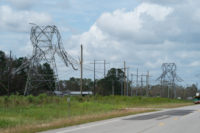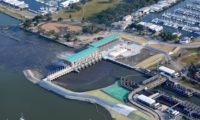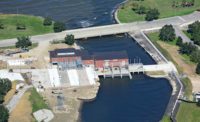It’s taken over five decades, a fast-tracking of federal funds and over two years of surveying, acquiring and clearing land, but on July 26, federal, state and local officials finally broke ground on a levee project along the western shores of Lake Pontchartrain designed to provide hurricane and storm protection to a three-parish area where 60,000 people have little to no defenses in place.
Spanning 18.5 miles from the Bonnet Carre Spillway to the Mississippi River Levee near Garyville, the $760-million West Shore Lake Pontchartrain Hurricane Protection system would bring 100-year levels of storm-surge protection across the east bank of St. Charles, St. James and St. John the Baptist parishes. The project is a joint effort between the U.S. Army Corps of Engineers, which will construct the project; the Coastal Protection and Restoration Authority (CPRA), the non-federal sponsor; and the Pontchartrain Levee District, the regional entity that will maintain and operate the levee system. The system will include 17.5 miles of levees, one mile of T-wall, drainage structures, pump stations and several non-structural protection measures.
A Five-decade Wait
Even though the official groundbreaking just took place, the new levee system has been over 50 years in the making. The project began as a 1970 study of the area between the Mississippi River and lakes Pontchartrain and Maurepas, amidst concerns by parish leaders about storm protection after Hurricane Betsy devastated the area in 1965.
The project gained Congressional authorization in 1971. But because of a lack of funding, it sat on a shelf for decades despite multiple attempts to move it forward. After Hurricane Isaac flooded 7,000 homes in the area in 2012, Congress in 2016 authorized the project amidst pressure from state and local leaders. It received full federal funding in the Bipartisan Budget Act of 2018 after state congressional leaders pushed for priority hurricane and flood protection funds.
Before any shovels could hit the ground, the project had to undergo two-plus years of extensive surveying work and investigations. “When the money for this project was authorized, it was not a shovel-ready project. It was not finished being designed. There’s been a lot of behind-the-scenes work going into this,” says Monica Gorman, executive director for the Pontchartrain Levee District.
The project will be a first of its kind for this area because unlike the $14.6-billion New Orleans Hurricane and Storm Damage Risk Reduction System, there is no existing right of way access to the levee site. The project also calls for building a 15-ft levee in virgin swampland with poor soil conditions.
“You’ve got to determine what is the best way to build an earthen levee in a swamp—a freshwater swamp at that,” Gorman says. “So there were lots of investigations, lots of surveys that went into this.”
To make way to access the site, the levee district worked with the state and the Corps to identify and acquire the land. Over and above the $750-million project amount, the state had to come up with about $48 million to secure the land, easements and right of way for the project.
As of the groundbreaking, the project had secured 90% of lands, easements and rights of way, Gorman says.
Construction of the project is being funded through a state and federal cost share, with the feds covering 65% of the project and the state picking up 35%. The state will have to repay its share, about $266 million, to the feds over a span of 30 years.
The levee board will have to continue to pay to maintain and operate the levee over the course of its lifespan. Those costs are yet to be determined.
Contracts and Complexities
To date, the Corps has awarded five contracts, totaling $45.8 million, to clear trees and excavate and stockpile levee material from the Bonnet Carre Spillway. The Corps has estimated it will need 7 million to 9 million cu yd of borrow material to construct the levee.
Bradley Drourant, senior project manager for the Corps’ New Orleans district, told ENR that the project has also advertised a contract for constructing multiple access roads and expects to award that contract in August.
Existing contracts include: $2.8 million to Quality First Construction of Covington, La., for tree clearing; $20 million to Greenup Industries of Gonzales, La., for stockpiling clay; $9 million to Greenup Industries for stockpiling clay; $9 million to North Wind Construction Services of Knoxville, Tenn., for sand stockpiling; and $5 million to Delta Land Services of Port Allen, La., for mitigation bank credits.
The project is relying on a hybrid structural and non-structural levee system because of the more rural, and less dense nature of the development in the three parishes, versus the more urban and suburban Orleans and Jefferson parishes, Drourant says.
Among its many complexities, the project will likely involve sleeving pipelines through floodwalls, directional drilling and raising several high voltage transmission lines, Drourant says. “The largest challenges to date have involved working with utility and pipeline owners to ensure that we can legally and safely cross their lines,” he says.
The project will also include multiple utility, interstate and highway crossings. The western reaches of the project could serve as a guide levee for a proposed project to divert freshwater to the Maurepas Swamp.
The West Shore Lake Pontchartrain project is slated for completion by 2024.





Post a comment to this article
Report Abusive Comment